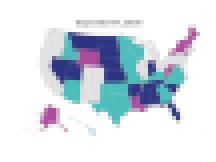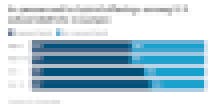Everybody wants to get kids back into schools—but the worsening COVID-19 pandemic seems to get in the way. Some states and local governments have issued rules that schools can reopen only if infection rates in the community are below a certain threshold. And even though early evidence suggests that school reopenings have not produced significant COVID-19 spread, many educators, parents, public health officials and others are still concerned about safety.
But as it turns out, districts in states with high COVID-19 positivity rates appear to be more likely to offer schooling with some physical component—through providing fully in-person or hybrid instruction as options—than their peers in states where infection rates are lower.
That’s a key finding from an EdSurge/Social Context Labs analysis of 375 school district reopening plans across all 50 states and Washington D.C., representing a diversity of geographies, COVID-19 infection rates and poverty levels.
Based on the plans captured in the database, we calculated the percentage of districts in each state that are offering in-person and/or hybrid instruction (as opposed to remote learning as the only option). Then we looked at COVID-19 positivity rates in each state, based on data from John Hopkins University’s Coronavirus Resource Center. Local infection rates may differ significantly within states, but this approach provides a glimpse of general trends.
This analysis found that a greater percentage of districts in high-positivity states offered in-person and/or hybrid classes than those in low-positivity states on all four of the dates for which we compiled data. (See animated graph below.)
Between 51% and 63% of districts in states with positivity rates of 5% or below offered in-person and/or hybrid instruction over the four dates examined in September and October. On the other hand, between 83% and 100% of districts in states with COVID-19 positivity rates exceeding 20% offered in-person and/or hybrid instruction.

These observations appear consistent with what Robin Lake and her team have been seeing. She is the director at the Center for Reinventing Public Education (CRPE) at the University of Washington at Bothell, a group that has been tracking reopening plans among a representative sample of nearly 500 districts across the country.
In late August, CRPE analyzed whether school reopening plans were following guidelines published by the Harvard Global Health Institute, which offered guidance on whether districts should offer remote or in-person instruction, based on COVID-19 infection rates. CRPE found that districts in states in the South, including Florida, Georgia and Texas where infection rates have been high, were not following this recommendation, as many districts planned to reopen in person.
CRPE examined whether the political environment was a factor. Districts that planned to reopen where COVID-19 rates were higher than the Harvard recommendations were 72 times more likely to be in states with Republican governors.
Researchers also found that districts in some coastal states were too cautious in their reopening plans, meaning they did not offer in-person components even though the Harvard guidelines suggested they could safely do so based on low infection rates. Districts with plans that were labeled “too cautious” were 27 times more likely to be in states with Democratic governors, according to CRPE.
“Politics has an outsized influence on school reopenings,” says Lake in an interview with EdSurge. “It doesn’t make any sense to have these rubber ruler measures going where one state thinks it’s fine to come back when rates are skyrocketing, and another state thinks it’s never fine to come back. It’s kind of a ridiculous situation.”
Mapping In-Person and Hybrid Instruction By State Over Time
Which are the states where districts are more likely to physically reopen despite high infection rates? And which are the states where districts are sticking with remote instruction, despite low COVID-19 positivity rates?
A scatterplot representation of our data collected on Sep. 1 and Oct. 15 shows a general movement toward in-person instruction across the country, even as the number of states with higher COVID-19 positivity rates grow. (See scatterplots below. Hover over points to view COVID-19 positivity rate and percentage of districts offering in-person and/or hybrid learning for each state among the sample in the EdSurge/Social Context Labs database. See notes on scatterplot methodology here.)
On Sept. 1, 14 states had both high rates of infection, and a high percentage of districts offering in-person/hybrid schooling. On Oct. 15, this number expanded to 18 states. And during this period, the number of states with COVID-19 positivity rates above 20% rose from 1 to 4.
The analysis also shows a slightly higher rate of in-person/hybrid schooling options available among districts in states with relatively low COVID-19 positivity rates. On Oct. 15, 10 states showed low positivity rates and high rates of in-person/hybrid schooling, compared to nine states on Sept. 1.
Displaying this data on a bivariate map shows regional variation. (See animated map and legend below.) States in the northeast have trended toward more-in person school and lower COVID-19 positivity rates during the time period we examined. Meanwhile, states in the Plains, Rocky Mountains and South have trended toward more in-person school and higher-positivity rates.
Significantly, a number of states fit neither pattern. For example, California’s positivity rate has remained relatively low during September and October, but California districts in our sample did not see a movement toward more in-person schooling.

Dark purple indicates higher positivity rates and more in-person schooling. Teal indicates higher positivity rates and less in-person schooling. Light purple indicates lower positivity rates and more in-person schooling. Gray indicates lower positivity rates and less in-person schooling. See notes on map methodology here.
A Trend Toward More Schooling With Some In-Person Learning
On the whole, more and more districts are reopening schools for students. The percentage of districts in the EdSurge/Social Context Labs database that offered fully in-person and/or hybrid attendance structures grew from 215 districts (57%) to 257 districts (69%) from Sept. 1 to Oct. 15. (See graph below.) During the same time period, over 90% of districts in the sample offered fully remote instruction as either a choice or as the only option.

That finding is consistent with other analyses of district plans. Earlier this month, The Washington Post examined 50 large districts and found that an increasing percentage were offering or planned to offer instruction that included an in-person component. CRPE found a similar trend among 106 large districts whose plans it has been tracking, with 69 districts planning to offer instruction with some in-person components by the end of this month, up from 24 in early September.
Researchers, educators, parents and others hoping for a science-informed approach to school reopenings may be disappointed that, to date, there has been little consistency in how COVID-19 infection rates have informed school policy. It is difficult to know whether this will continue during an anticipated “second wave” of infections—or after the results from a closely watched election.


